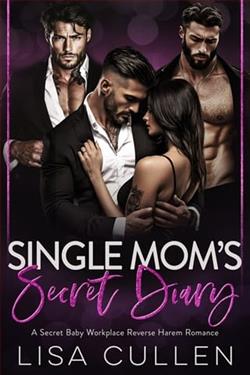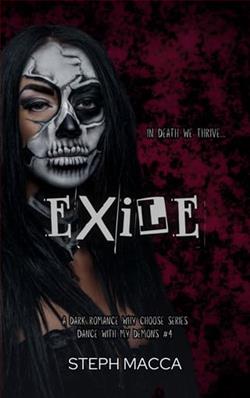Page 80 of The Grave Artist
In his kitchen, which was suffused with morning sunlight, Damon pulled on the latex gloves and picked up the box of blades. Then he ambled to the huge living room.
There was no secret code or anything like that to enter his den, though the door was not obvious. It seemed to be yet another floor-to-ceiling mirror. A simple push on the frame and the heavy panel swung inward. He flicked on the light and entered what appeared to be a space typical of an art gallery or museum. Prints and paintings covered the walls. A comfortable light-brown leather couch in the center, some armchairs, a few end tables, and nods to the business side of Damon’s life: shelves, a scanner, a computer, a file cabinet, a worktable, an office chair, which could scoot across the tile floor fast as a sports car.
At the back was the special room, partially hidden by a thick purple (what else?) curtain.
WhereShewaited.
A rattle of the razor blades.
His eyes drifted to a print—a good one—of Vasili Pukirev’s paintingUnequal Marriage, which portrayed an elderly nobleman marrying a young woman, possibly a teen. His expression was haughty and imperious. Her downcast eyes radiate sorrow. She is undoubtedly poor and forced into the union by circumstance.
As he sat down at the workstation, his thoughts were, not surprisingly, drawn instantly to September 15, some years ago, the day that changed his life.
For certain reasons, after Sarah Anne Taylor’s murder, Damon had decided to try leading a normal life. Why not? Many serial killers were able to juggle. He had finished his courses, with honors, and started teaching at a community college. Then he met someone, an elementary school teacher and part-time grad student, Felicia McNichol. He began dating the willowy brunette.
Not a bad life.
It was faculty dinners, finding a town house, Sunday-morning sex, movies, drives to San Simeon ...
He still lived in his dreaded family home but, on the plus side, was tended to by Miss Spalding, who would not hear of him staying on campus or in an apartment.
He proposed to Felicia, who was working full-time at an elementary school in Hollywood. She preferred teaching sixth graders, explaining that they were at that perfect age,pastbabbling silliness andbeforehormonal dystopia.
And to Damon’s delight, she said yes.
September 15 was the day they would exchange vows, sealing their love in the bonds of matrimony. And begin their new life together—never to be alone again.
The ceremony was to be small. Both their parents were gone at that point, and they were only-children. So the guests would be mostly friends.
That fateful morning, Damon had gone to the hotel to see about final arrangements, while Felicia remained at her house in Beverly Hills to await girlfriends who would help with the hair and makeup.
They had discovered a wonderful venue for the ceremony and reception: a hotel and spa with a pavilion on a lake, offering lush gardens providing the perfect backdrop for an array of beautiful bridal photos. There, he made a few last-minute decisions on the menu, the decorations and the seating, then returned home to put on his best suit.
Miss Spalding greeted him, and he knew instantly something was amiss. It wasn’t her face—which was a constant somber mask. No, it was her clothing. By then she should have changed from her typical floor-length gray frock to the pastel taffeta she’d selected for the wedding.
She had not.
She gave him one of her solid embraces—which lingered a bit too long—and said, “Come inside and sit down, Little ...”
She’d stopped short of calling him her Little Pup, that nickname from his early childhood. Her instinctive move to comfort him with the familiar term reinforced his sense of foreboding.
Damon had not taken a seat but stood with arms crossed over his chest as she delivered the news. There had been an accident, Felicia was dead. Before her friends arrived, she’d gone for a swim and slipped climbing out. Her head hit the travertine coping, knocking her unconscious. Then she’d fallen back in the water and drowned.
Damon had mutely stared out the window. He waved away Miss Spalding’s offer of iced tea and cottage pie. She suggested some junk food, candy, always good for comfort.
“No,” he’d exhaled.
She said she knew how upset he would be, so she would handle notifying everyone of the tragedy, and would field any calls, if he liked.
That was fine. He didn’t want to speak to anyone. Something odd, something significant, was occurring within him and he wanted no distractions.
He went into his room—a large space, as big as some bungalows whole families lived in. He paced slowly past the contents: the many books of art for classwork, the framed posters and prints that were the souvenirs of the visits to art museums and galleries Miss Spalding had taken him to from almost the first week she had moved in: the Getty, the Broad, the county museum, those in the various colleges in the area.
An observer might be curious to see the high art was interspersed with the low: racks of DVDs of slasher films and violent computer game cartridges—all of which Miss Spalding was happy to let her Little Pup indulge in.
Damon stopped pacing when he came to his desk and gazed at the one photo that sat upon it: Felicia’s graduation picture.
And realized with a jolt what that sense of significance was, the one that had been wafting about him since Miss Spalding had delivered the horrific news.















